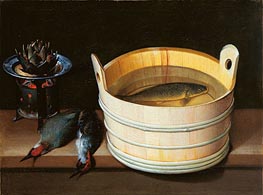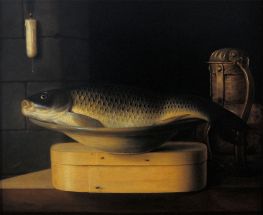Sebastian Stoskopff Giclée Fine Art Prints
1597-1657
French Baroque Painter
Sebastian Stoskopff emerged as one of the most significant still life painters of seventeenth-century Germany, though his reputation would lie dormant for nearly three centuries before a remarkable rediscovery in the 1930s. His distinctive approach to still life painting, characterized by an almost metaphysical reduction of objects to their essential forms, sets him apart from his contemporaries and anticipates modernist concerns by several centuries.
Born in 1597 in Strasbourg, Stoskopff's artistic journey began with remarkable precocity, displaying extraordinary talent in drawing by the age of fifteen. The city council's support proved instrumental in launching his career, initially apprenticing him to Friedrich Brentel, though this arrangement focused solely on drawing rather than painting. Following his father's death in 1615, a second intervention by the council placed him under the tutelage of Daniel Soreau in Hanau, a fortuitous arrangement that would shape his artistic development.
The years in Paris, from 1622 to 1639, marked Stoskopff's artistic maturation. This period yielded his first large-format works, including the allegorical paintings "Summer" and "Winter," now housed in Strasbourg. His time in the French capital coincided with a broader European movement toward still life painting as a serious genre, though Stoskopff's interpretation remained distinctly his own, characterized by an almost austere approach to composition and a masterful rendering of glass and metallic surfaces.
Upon returning to Strasbourg in 1639, Stoskopff's relationship with the guild system proved contentious, reflecting his fierce independence as an artist. His resistance to maintaining a traditional workshop with apprentices marked him as an outlier in the artistic community, though his technical mastery and growing reputation secured his position. This period coincided with his marriage to his youngest sister's stepdaughter in 1646, a union that helped cement his social standing.
The final chapter of Stoskopff's life unfolded in Idstein, where he found patronage under Count Johannes von Nassau und Idstein. This relationship proved crucial for his late works, though it ended tragically with his death in 1657, initially attributed to excessive drinking but later revealed to be murder following a witchcraft trial. This dramatic conclusion to his life adds a darker dimension to our understanding of the artist, whose works are characterized by their thoughtful serenity and measured control.
Stoskopff's legacy rests in his ability to distill still life painting to its purest essence. While his connection to Georg Flegel's influence remains a matter of scholarly debate, his distinctive approach to the genre - particularly his masterful depiction of glass vessels and his sophisticated understanding of light - establishes him as a singular figure in seventeenth-century European painting. His works, now preserved in major museums worldwide, from the Louvre to the Metropolitan Museum of Art, testify to his enduring significance in the development of still life painting.
Born in 1597 in Strasbourg, Stoskopff's artistic journey began with remarkable precocity, displaying extraordinary talent in drawing by the age of fifteen. The city council's support proved instrumental in launching his career, initially apprenticing him to Friedrich Brentel, though this arrangement focused solely on drawing rather than painting. Following his father's death in 1615, a second intervention by the council placed him under the tutelage of Daniel Soreau in Hanau, a fortuitous arrangement that would shape his artistic development.
The years in Paris, from 1622 to 1639, marked Stoskopff's artistic maturation. This period yielded his first large-format works, including the allegorical paintings "Summer" and "Winter," now housed in Strasbourg. His time in the French capital coincided with a broader European movement toward still life painting as a serious genre, though Stoskopff's interpretation remained distinctly his own, characterized by an almost austere approach to composition and a masterful rendering of glass and metallic surfaces.
Upon returning to Strasbourg in 1639, Stoskopff's relationship with the guild system proved contentious, reflecting his fierce independence as an artist. His resistance to maintaining a traditional workshop with apprentices marked him as an outlier in the artistic community, though his technical mastery and growing reputation secured his position. This period coincided with his marriage to his youngest sister's stepdaughter in 1646, a union that helped cement his social standing.
The final chapter of Stoskopff's life unfolded in Idstein, where he found patronage under Count Johannes von Nassau und Idstein. This relationship proved crucial for his late works, though it ended tragically with his death in 1657, initially attributed to excessive drinking but later revealed to be murder following a witchcraft trial. This dramatic conclusion to his life adds a darker dimension to our understanding of the artist, whose works are characterized by their thoughtful serenity and measured control.
Stoskopff's legacy rests in his ability to distill still life painting to its purest essence. While his connection to Georg Flegel's influence remains a matter of scholarly debate, his distinctive approach to the genre - particularly his masterful depiction of glass vessels and his sophisticated understanding of light - establishes him as a singular figure in seventeenth-century European painting. His works, now preserved in major museums worldwide, from the Louvre to the Metropolitan Museum of Art, testify to his enduring significance in the development of still life painting.
2 Sebastian Stoskopff Artworks

Giclée Canvas Print
$61.42
$61.42
SKU: 8327-SES
Sebastian Stoskopff
Original Size:54.5 x 73 cm
Kunstmuseum, Basel, Switzerland
Sebastian Stoskopff
Original Size:54.5 x 73 cm
Kunstmuseum, Basel, Switzerland

Giclée Canvas Print
$67.74
$67.74
SKU: 19881-SES
Sebastian Stoskopff
Original Size:47 x 57 cm
Kunsthalle, Bremen, Germany
Sebastian Stoskopff
Original Size:47 x 57 cm
Kunsthalle, Bremen, Germany